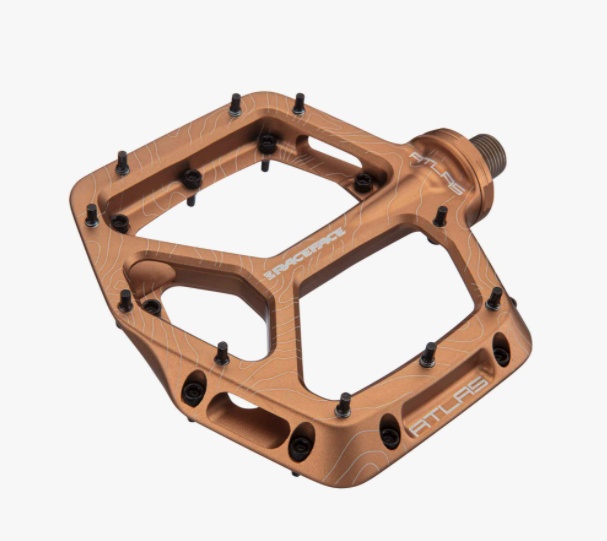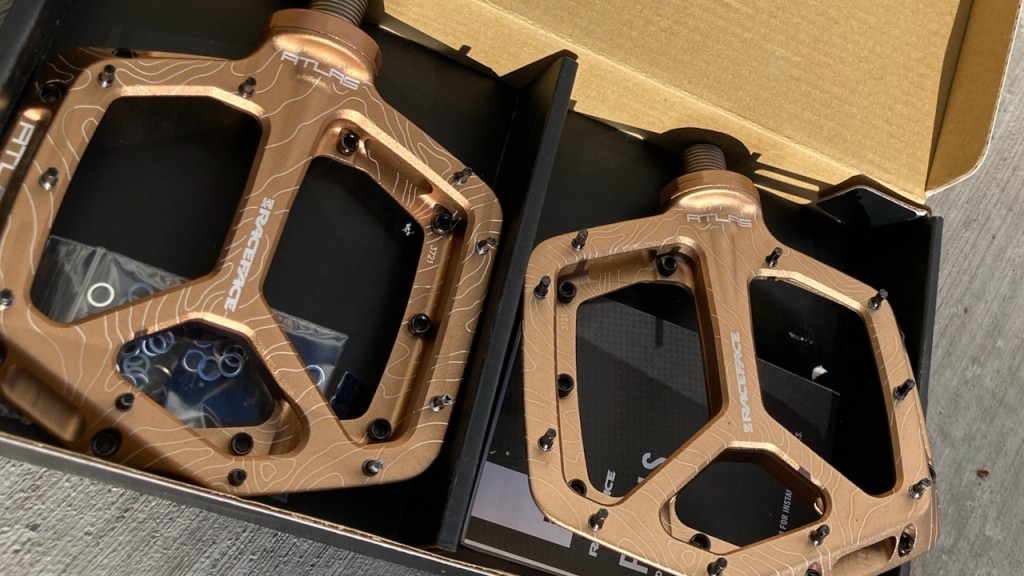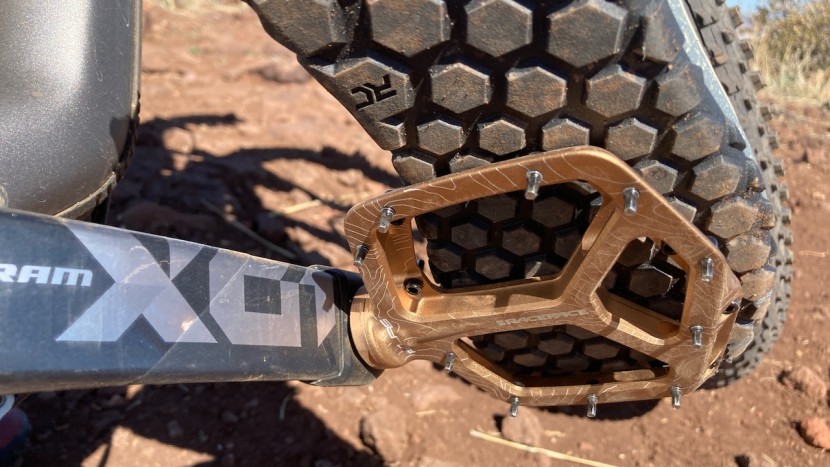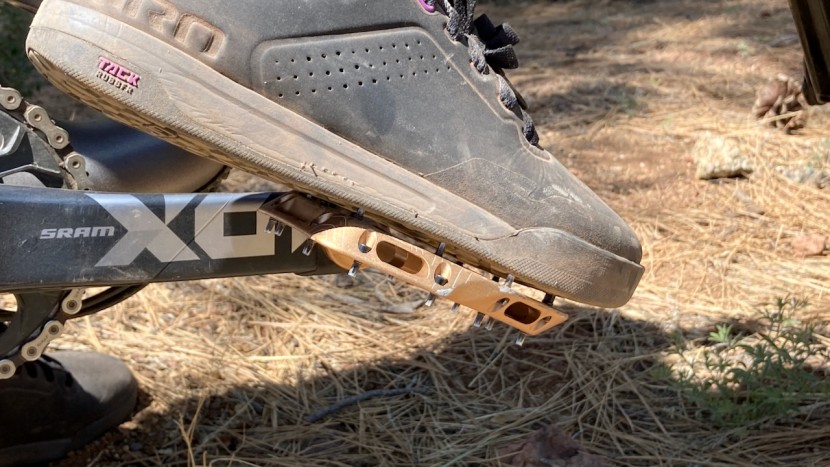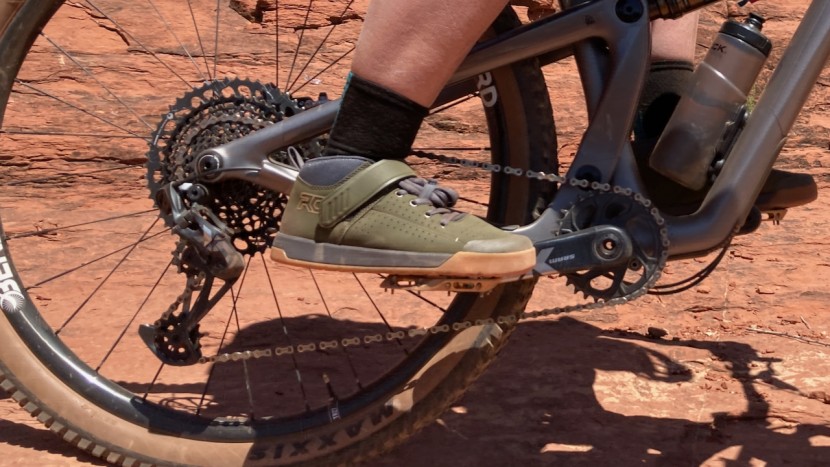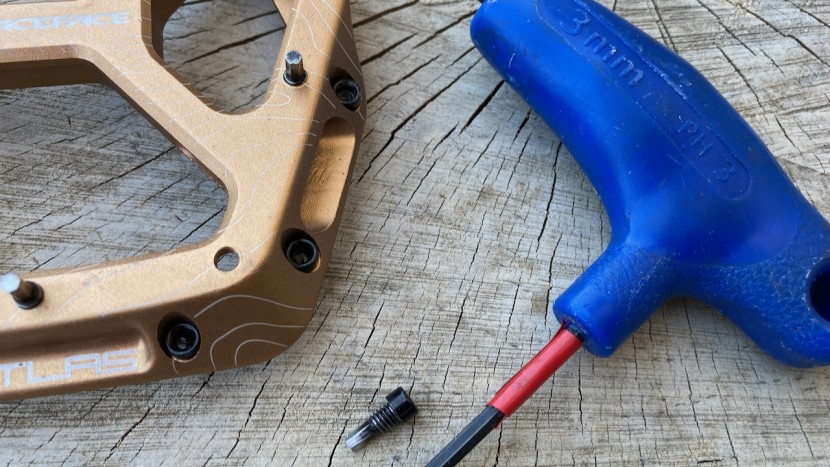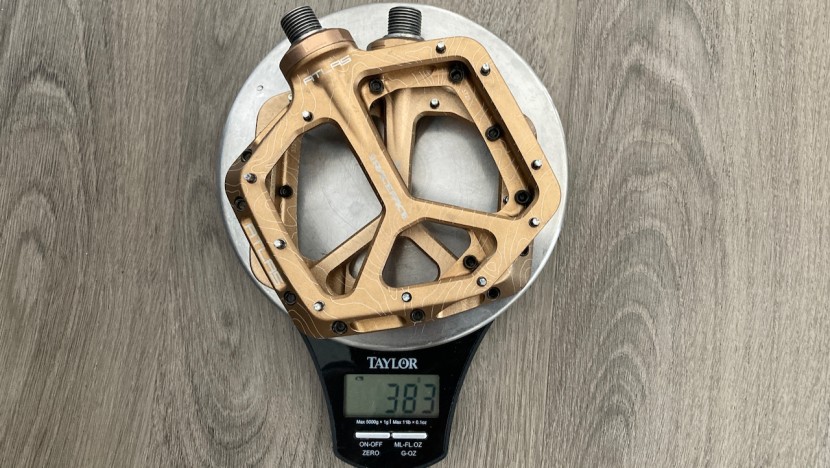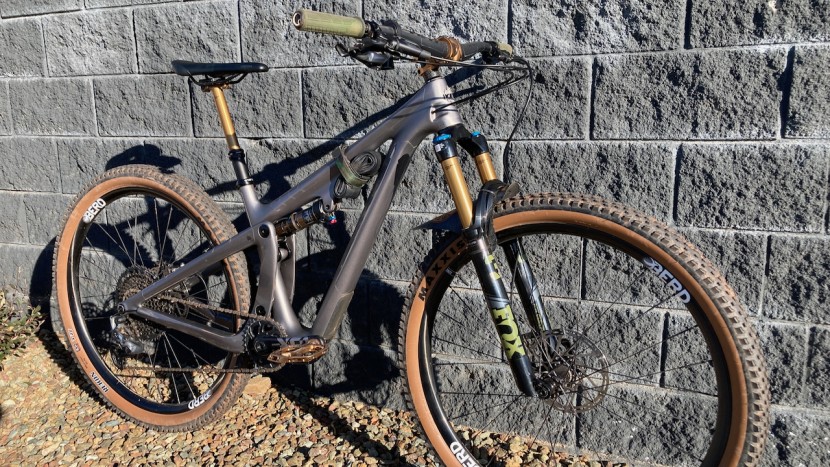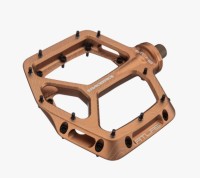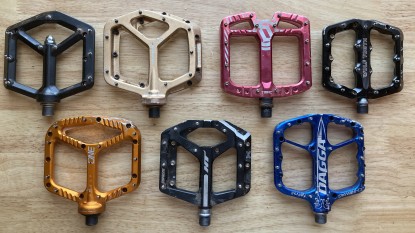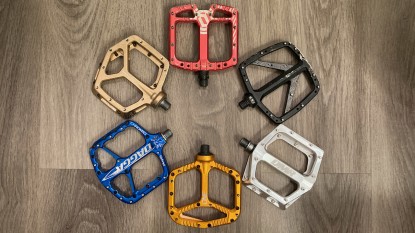Race Face Atlas Review

Our Verdict
Our Analysis and Test Results
The newly redesigned Atlas from Race Face has a larger platform, is thinner, easier to service (with the proper tool) than its predecessor, and comes with a lifetime warranty. The Atlas is designed as a gravity-oriented pedal, but thanks to its lightweight design, slim profile with chamfered edges, and gobs of grip, this pedal is at home on almost any trail. The 6061 aluminum platform is concave and measures 111 mm x 107 mm and has chamfered edges making it less prone to getting hung up on rocks. The 10 adjustable height pins are long, measuring over 6mm in length out of the box, have loads of traction on a variety of terrain, and work great with a variety of shoes.
Grip and Traction
The Atlas strikes a great balance for grip. With 10 long hex-shaped pins per side, your feet will stay confidently planted to the pedals, and be warned they are sharp and will draw some blood if you accidentally hit your calf or shin with them.
Out of the box, the installed pins are a little over six millimeters in length, and in our testing, we found this length great for biting into our shoe's outsole. Race Face uses a bottom load pin design and provides a bag of additional pins and washers to adjust their height so that you can dial in the pin's grip to your tastes. This also allows you to create a more concave platform if you wish.
The pins are placed along the perimeter of the pedal body, and there are no pins on the axle. We tested the pedals with full-length pins and were impressed with the grip. While the Atlas is not the grippiest pedal in our test, it does strike a great balanced feel that keeps your feet in place while still being able to reposition without too much difficulty. You can remove your foot easily enough, but it does not slide around under the pedal, even on loose and chunky descents.
When first riding the pedal, it took a few moments to find the sweet spot, but once we did, our feet were firmly planted on the pedal, and the placement was easy to remember. We found we could feel more of the Atlas' pins through thinner and softer soles and prefer a shoe with a slightly stiffer midsole with them.
Platform
The Atlas has an average profile size compared to other pedals in our test, measuring 111 mm x 107 mm. We found them to work well with shoe sizes from a women's EU 39 to a men's EU 45. However, riders with smaller feet may find the platform a tad too wide for their liking. Some riders have stated the outboard bearing design interferes with the inside of their shoe, but our tester with size EU 45 feet did not experience this problem.
The Atlas has a concave design measuring 14.8 mm at the leading and trailing edges and tapering to 12.8 mm at the axle. It's not the thinnest profile in our testing, but we have fewer pedal strikes with the Atlas than with thicker pedals. This is in part due to the chamfered sides of the platform. This means the edges have a symmetrical slope to them and are able to slide or bounce off rocks more easily than a pedal with a square edge.
Ten pins line the perimeter of the concave 6061 aluminum body; depending on your shoe's stiffness, your foot will sink into the pedal's platform. There is no feeling of holes or soft spots underfoot thanks to the diagonal support brace that runs from the axle to the body's perimeter.
Mobility
The redesigned Atlas is compatible with crank booties without using multiple pedal washers. The spindle design interfaces well with SRAM and Race Face crank booties and does not impede the rotation of the pedals. The rotation is smooth and rotates about one revolution with an intentional foot flick, meaning the pedal won't rotate freely if you flick it or take your foot off.
The Atlas is one of the easier pedals in our test to adjust your feet. Unlike pedals that require a total unweighting of the pedal to adjust your foot position, we can make small adjustments by only slightly unweighting our foot. Riders can also use the provided washers to reduce the pin height and make the pedals less grippy or add additional concavity to the pedal.
Servicing
The redesigned Atlas is the simplest pedal to service in our test with the proper tools. Unlike most pedals that require two hex wrenches or a hex and socket, the Atlas only requires a 30 mm socket or a vice to reach the axle. We disassembled our pedals using a 30 mm chamfer-less socket with a ratcheting handle, although a non-chamfer-less socket can also be used. Since we didn't have our vice set up, we put the socket on the Body Cap, placed the pedal on a rubber mat, and stood on the pedal, and with one pull of the ratchet, the Body Cap was loose. The process was simple. On the website, Race Face says you can also use Knipex pliers to loosen the Body Cap.
Once the cap is removed, you can easily pull the axle assembly from the body to regrease. The Atlas uses the 6802 sealed cartridge bearing, which is larger than traditional pedal bearings, and spreads the forces out over a larger area. Bearing replacement requires additional tools and the bearing kit from Race Face. The Atlas comes with a lifetime warranty providing peace of mind should a part fail.
Race Face provides four replacement pins and 40 washers with the Atlas pedal. The pins are loaded from the bottom of the pedal, and a three-millimeter hex is required to replace them. Depending on the location of a bent pin, it can be easy to remove or require a little more patience. On one side of the pedal, the pins are easily accessible; on the opposite side, they are slightly recessed. Bent pins on the recessed side can take a bit more finesse to extract if they are bent.
Weight
The Atlas weighs 383-grams, comparable to other aluminum body pedals with a similar platform size.
Value
The Atlas is one of the more expensive pedals in our review, but we feel they warrant their higher price tag for their quality and performance. Their ease of service is a bonus, as is the lifetime warranty.
Conclusion
The Atlas is a solid performing pedal in our test and scores well across our metrics. Its concave platform supports our feet, and the pins provide great grip on our shoes without being excessively grippy. The thin profile and chamfered edges help prevent pedal strikes and getting hung up on rock pinches. Our testers are very impressed with how simple the axle is to service and that it can be done with just a 30 mm socket and wrench, making greasing the axle especially quick and easy. The quality construction is evident on this pedal, and the extra washers and included pins are a nice touch. The updated Atlas is a quality, versatile pedal that can take a beating.
| Awards | |
|---|---|
| Price | $189 List Check Amazon (on sale!) |
Overall Score  |
|
| Star Rating | |
| Bottom Line | This top-performing pedal has excellent grip, and a well-rounded performance and is a great choice for a variety of terrain |
| Pros | Great grip, easy to service, large platform, quality construction, smooth rotation |
| Cons | Expensive |
| Rating Categories | Race Face Atlas |
| Grip and Traction (25%) | |
| Platform (25%) | |
| Mobility (20%) | |
| Servicing (15%) | |
| Weight (15%) | |
| Specifications | Race Face Atlas |
| Measured Weight (per pair) | 383 g |
| Traction Pins (per side) | 10, 3 mm hex head bottom loading, adjustable height |
| Measured Platform Dimensions (millimeters) | 111 mm x 107 mm |
| Platform Profile (millimeters) - not including pins | 14.8 mm leading and trailing edges, 12.8mm at axle |
| Concavity | 1mm from edges to axle |
| Q Factor / Distance from cranks to furthest pin | 117mm |
| Bearings | 6802 sealed cartridge bearing |
| Body Material | 6061 Aluminum |
| Pedal Wrench Type | 8 mm hex |


